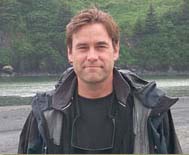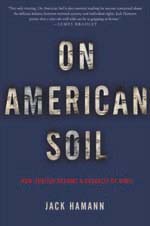- Categories:
History Top Ten Pick Explores an Injustice On American Soil
A writer never knows where he may strike gold. For Jack Hamann -- author of On American Soil: How Justice Became a Casualty of World War II (Algonquin), a Book Sense History Top Ten Pick -- it was at a 1987 Seattle hearing about a proposed expansion of a sewage treatment plant.
 "I was a [television] journalist back then," Hamann explained recently in a telephone interview from Seattle, "and I had been assigned, for at least the second or third time, to go cover a process story about ... this very large city park here ... As the press conference wore on, I was in the back of the room, with my eyes kind of glazing over, next to a young woman who was a ranger for the city park. And she turned to me and said, 'You know, there's a lot of really interesting things here.' I said, 'Oh yeah? Okay, I'll bite: What are you talking about?'
"I was a [television] journalist back then," Hamann explained recently in a telephone interview from Seattle, "and I had been assigned, for at least the second or third time, to go cover a process story about ... this very large city park here ... As the press conference wore on, I was in the back of the room, with my eyes kind of glazing over, next to a young woman who was a ranger for the city park. And she turned to me and said, 'You know, there's a lot of really interesting things here.' I said, 'Oh yeah? Okay, I'll bite: What are you talking about?'
"She said, 'Well, this used to be a big Army fort called Fort Lawton.... There's just all sorts of unusual things here.' The first one she mentioned was a neat little military graveyard tucked into one corner of this giant park. As you would expect, most of the headstones are laid out in a pattern in that very uniform, military way. But over to one side, right out of the quadrant, was a single headstone like none of the others -- a very large, Roman-style column, designed to look as if its top had been broken off. At the base, she said, were some words that she thought were [written in] Latin, or some other language.
"So, at the end of the press conference, I looked at the little map she had drawn and scooted over there. As it turned out, the words were in Italian ... but it was easy enough to read that the date of this guy's death was August 14, 1944.
"Several days later, I went -- this was back in 1987, there was no Internet -- to the Seattle public library and began to look in the archives. There was nothing on that date about anybody dying, or on the following day. But two or three days later, there [had been] a banner headline in the local papers, saying there had been a big riot in Fort Lawton, that a man had been lynched. Then, as I continued to read the daily headlines, it turned into this giant court-martial, with 43 African-American defendants, and Leon Jaworski as the prosecutor. I was hooked. That's how I started."
 Hamann then spent about a year, he said, researching and filming a documentary for his Seattle TV station about the Fort Lawton incident, which involved the death of an Italian prisoner-of-war, and its aftermath: the largest and longest Army court-martial of World War II. "It was very well-received," he said of that program, "won some awards, all that sort of thing."
Hamann then spent about a year, he said, researching and filming a documentary for his Seattle TV station about the Fort Lawton incident, which involved the death of an Italian prisoner-of-war, and its aftermath: the largest and longest Army court-martial of World War II. "It was very well-received," he said of that program, "won some awards, all that sort of thing."
Hamann soon took a job producing documentaries for CNN. But for the next decade, that Fort Lawton story stuck in his mind. "All that time," he said, "friends of mine would say to me, 'You know there's something else to that, Jack; because every time you tell me the story, something just doesn't make sense.' The [official] story was that these guys had been involved in a race riot. And even though we had done some primary interviews with some of the people who'd been there [and who had denied that], we didn't have any of the original documents; so it was kind of their word against history's."
Finally, when the second of Hamann's and his wife's two children had gone off to college, "We said, 'Maybe we should look at this topic, do the research, see if we can convince an agent and then a publisher,'" he explained.
Hamann and his wife, Leslie, began a two-year resource odyssey, which took them to such institutions as the FDR presidential library in upstate New York, the Truman Library in Missouri ("a lot of Truman-era decisions about whether the Army should be desegregated, whether the military code should be rewritten, all had things to do with this particular case"), the library at the University of Chicago, and -- most memorably -- the College Park National Archives near the University of Maryland: "A wonderful place," said Hamann, "an addicting place to be.... It's the repository of hundreds of millions of documents.... We made several trips there. We'd be the first ones in line in the morning, the last ones out! You'd grab a Starbucks before you went in, have a beer and a burger late at night, and get back in line the next day."
The couple eventually identified nearly 400 people connected to the trial. "Some of them were critical characters, people we had to know," said Hamann, "but they had names as common as 'Bill Jones.' My wife, who is a brilliant researcher, was able to find the disposition, if you will, of all but about 50 of them.... And one day we picked up in our car, and we drove the United States of America, to all these small towns -- mostly throughout the South -- where we found either surviving people from the actual event, or, in many cases, family members or other associates. We interviewed all of them."
This diligent research also uncovered a previously undisclosed official document, which proved crucial to their project. "As it turned out," said Hamann, "the Army -- undisclosed to essentially anybody, including us for the longest time -- had sent an incredibly interesting and colorful Army general ... to investigate and ferret out problems with the command at any Army installation around the world. He had this somewhat secret mission of trying to find out how in the world it could be that there could be a riot and a death and all these other things, all under the command of the people in charge of this fort. He left hundreds and hundreds of pages of transcribed interrogations, plus extensive, well-documented reports."
The details gleaned from those reports added immeasurably to the interest of the story that he was pursuing, Hamann said: "In essence, what happened was, even though Leon Jaworski as prosecutor and apparently several members of the court-martial itself knew of the existence of this extremely damning report, it was kept entirely out of the trial, essentially hidden -- just kind of pushed away.... The man that I believe really did commit the murder was ... himself court-martialed -- but, yet again, in secret, and only after all these other men had been tried and convicted for the crime that I think he did.
"So there's a lot of shocking stuff. And particularly given that the reputation of Leon Jaworski, which is otherwise just spectacular -- president of the American Bar Association, Watergate prosecutor, member of the Warren Commission, LBJ's private attorney, the first attorney to prosecute any crime anywhere in the world under the then-new Geneva Convention -- I mean, superstar.... Yet clearly, in this trial, he behaved in a way that the lawyers we talked to say was probably unethical at best."
The result of all that digging into the past is the just published On American Soil, which is earning good reviews and building strong interest among booksellers and early readers. Its author thinks this dramatic 60-year-old episode holds extra relevance for 21st century citizens: "The reporters for the local newspapers had the right instincts. They were being stonewalled by the Army, so they went to the local bars where enlisted men hung out; they began to ask questions, and began to print things." However, Hamann said that the Army quickly reacted to the early articles. "More disturbingly, months later, once the trial began, the reporters pretty much lost their initial skepticism, or simply just didn't pay attention," he noted, as the newspapers began "to dish out the Army line." From Hamann's perspective there is "a good lesson, I think, in terms of modern issues that we're facing, in the war in Iraq and otherwise: How often that first instinct of a good journalist should be trusted -- and not to forget that, just because you can be stonewalled or the issue seems to go away. You've got to revisit that idea." --Tom Nolan

